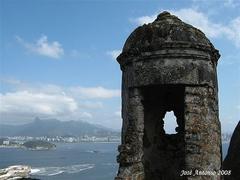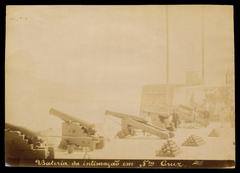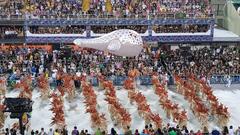Praça da República Niterói: Visiting Hours, Tickets, and Historical Sites Guide
Date: 04/07/2025
Introduction
Praça da República, centrally located in Niterói, Brazil, is a distinguished emblem of the city’s rich historical legacy and cultural dynamism. As both a civic center and a beloved public space, the square not only reflects centuries of social and political evolution but also stands as a living canvas of architectural beauty and community life. From its indigenous Tupi roots to its pivotal role in Brazil’s republican transition, Praça da República offers visitors a rewarding journey into the heart of Niterói’s identity (cidades-rj.axa.org.br).
This guide provides comprehensive information for visitors, including the history and cultural significance of Praça da República, architectural highlights, practical visitor details (such as opening hours and accessibility), travel tips, and nearby points of interest. Whether you are a history enthusiast, cultural explorer, or casual tourist, this article will help you make the most of your experience at one of Niterói’s most significant landmarks.
Table of Contents
- Introduction
- History and Cultural Evolution
- Architectural Heritage
- Social and Cultural Relevance
- Visiting Information
- Nearby Attractions
- Practical Tips for Tourists
- Frequently Asked Questions (FAQs)
- Conclusion
- References
History and Cultural Evolution
Indigenous and Colonial Foundations
Long before Portuguese colonization, the region that is now Niterói was inhabited by the Tupi people, whose presence left enduring marks on the area’s culture and geography. The city’s formal foundation dates to 1573, when Estácio de Sá established a settlement to defend Guanabara Bay, recognizing the site’s strategic importance for trade and defense (cidades-rj.axa.org.br).
Urban Development and the Rise of the Square
Through the 19th century, Niterói transformed from a coastal settlement into a bustling urban center, propelled by waves of immigration and the development of transport networks. Praça da República was conceived as part of this modernization effort—a central space designed to host civic life and symbolize the city’s growing importance (cidades-rj.axa.org.br).
Political Significance
Niterói played a crucial role in Brazil’s political landscape as the first capital of the state of Rio de Janeiro. Praça da República became synonymous with civic gatherings, political rallies, and celebrations, especially following the Proclamation of the Republic in 1889. The square’s central monument and architectural features commemorate this democratic legacy (cidades-rj.axa.org.br; Wikipedia).
Architectural Heritage
Urban Planning and Civic Center Vision
Praça da República is a showcase of early 20th-century urban planning. Designed as the nucleus of a grand Civic Center, the square was envisioned to bring together the city’s most important governmental and cultural institutions. The layout—characterized by symmetry, broad avenues, and ornamental gardens—was influenced by both Beaux-Arts and rationalist traditions (Wikipedia).
Notable Buildings and Monuments
Surrounding the square are some of Niterói’s most significant architectural landmarks:
- Câmara Municipal de Niterói (City Council): Known for its neoclassical facade, this building once housed the State Legislative Assembly and stands as a symbol of republican authority.
- Biblioteca Pública Estadual de Niterói (State Public Library): Completed in 1935, the library’s Italian Renaissance-inspired design adds artistic harmony to the ensemble.
- Fórum de Niterói (Courthouse): Another example of eclecticism, contributing to the square’s dignified atmosphere.
- Liceu Nilo Peçanha: This educational institution exemplifies the commitment to learning and civic engagement.
- Sede Regional da Polícia Civil: Reinforcing the area’s status as an administrative hub.
- Private Buildings: The Parthenon and Teatro Leopoldo Fróes add neoclassical and Art Deco elements, respectively (Wikipedia; WikiRio).
At the center stands the Monumento “Triunfo à República”, unveiled in 1927—a sculptural tribute to Brazil’s republican pioneers. The monument features a Roman chariot led by a female allegory of the Republic, surrounded by statues of influential figures and symbolic plaques bearing the names of state municipalities, each holding local soil (IPatrimônio).
Heritage Protection
Praça da República’s architectural ensemble is protected by the Instituto Estadual do Patrimônio Cultural (INEPAC), ensuring the preservation of its buildings, urban scale, and civic character. Restoration efforts maintain the integrity and authenticity of the site (Ipatrimonio).
Social and Cultural Relevance
Praça da República remains at the heart of Niterói’s civic and social life. The square is a venue for public festivals, traditional celebrations, and political events such as Carnival parades, Festa de São Sebastião, and commemorative ceremonies. Its open layout, shaded benches, and vibrant atmosphere make it a popular space for leisure, community gatherings, and cultural programming (Niterói Turismo; cidades-rj.axa.org.br).
The proximity to educational institutions like the Universidade Federal Fluminense (UFF) further enhances its role as a locus for academic and artistic activities (UFF).
Visiting Information
Hours and Entry
- Square Access: Open 24 hours a day, year-round; free entry.
- Public Buildings: Generally open Monday to Friday, 9:00 AM–6:00 PM. Check each institution’s website for updated schedules.
- Events: Some cultural festivals and exhibitions may have specific timings and may require advance registration or tickets.
Accessibility
- Wheelchair Access: Paved and level walkways facilitate wheelchair use, though assistance may be needed near the monument due to steps or uneven surfaces.
- Public Transport: Multiple bus lines stop near the square. From Rio de Janeiro, the ferry from Praça XV to Praça Arariboia is a scenic option, followed by a 15–20 minute walk.
- By Car: Paid parking is available nearby, but can be limited during busy periods (Housity).
Getting There
- From Rio de Janeiro: Ferry to Praça Arariboia or car/bus via the Rio-Niterói Bridge (travel time varies with traffic).
- By Taxi/Ride-share: Widely available; popular pick-up and drop-off point.
Best Times to Visit
For a pleasant experience, visit during daylight—ideally early mornings or late afternoons for softer light and fewer crowds. Weekends and public holidays bring lively markets and cultural events.
Events and Tours
- Cultural Events: The square hosts festivals, open-air concerts, and food markets throughout the year.
- Guided Tours: Local tourism offices and agencies offer historical walking tours that often include the square.
- Photography: The monument and architectural facades are excellent for photos, especially during golden hour.
Amenities
- Restrooms: Available in public buildings (during opening hours) and nearby cafés/restaurants.
- Shade and Seating: Benches and mature trees provide comfort for visitors.
- Wi-Fi and Kiosks: Free Wi-Fi and tourist information kiosks are available.
Nearby Attractions
- Municipal Theater of Niterói: Early 20th-century performance venue (Teatro Municipal João Caetano).
- Museu de Arte Contemporânea de Niterói: Iconic modernist museum.
- Praça Arariboia: Near the ferry terminal.
- Igreja de São Lourenço dos Índios: Historic church.
- Icaraí Beach: For relaxation and local cuisine.
Practical Tips for Tourists
- Dress: Light clothing, sunscreen, hat, and water, especially in summer.
- Language: Portuguese is spoken; translation apps are helpful.
- Safety: The area is well-patrolled, but remain aware of your belongings.
- Cleanliness: Use available bins to keep the square tidy.
- Photography: Respect interior photography restrictions.
Frequently Asked Questions (FAQs)
Q: What are the visiting hours for Praça da República?
A: The square is open 24 hours a day; public buildings are generally open weekdays, 9:00 AM–6:00 PM.
Q: Is entry to Praça da República free?
A: Yes, access to the square and monument is free. Some events may require tickets.
Q: Are guided tours available?
A: Yes, local tourism offices and agencies offer walking tours that include the square.
Q: Is the square wheelchair accessible?
A: Main paths are accessible, with some assistance needed near the monument.
Q: Are restrooms available?
A: Facilities are provided in adjacent public buildings during opening hours and in nearby cafés.
Q: How do I get there from Rio de Janeiro?
A: Take the ferry from Praça XV to Praça Arariboia, then walk or take a bus/taxi. Alternatively, use the Rio-Niterói Bridge by car or bus.
Conclusion
Praça da República is a vibrant symbol of Niterói’s layered history, blending indigenous heritage, colonial foundations, and republican ideals into a harmonious urban space. Its eclectic architecture, iconic “Triunfo à República” monument, and role as a social and cultural hub make it an essential destination for anyone exploring Niterói or Brazilian civic life. With free access, ample amenities, and proximity to key attractions, the square promises a memorable and authentic experience.
For the latest updates, event schedules, and guided tour options, consult local tourism resources or download the Audiala app. Embrace the opportunity to explore Praça da República and immerse yourself in Niterói’s historical and contemporary vibrancy.
References
- História da Cidade de Niterói – cidades-rj.axa.org.br
- Praça da República (Niterói) – Wikipedia
- Praça da República – Ipatrimonio
- Monumento à República – IPatrimônio
- Prefeitura de Niterói
- Niterói Turismo
- Housity – Niterói Guide
- Teatro Municipal João Caetano
- UFF – Universidade Federal Fluminense



